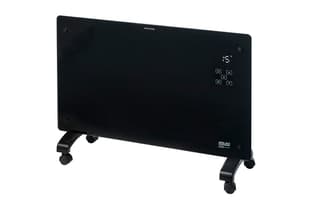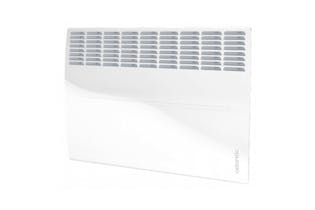Electric heaters
Find the best electric heater for your home with our buying guide and test results for 31 current and 19 discontinued models.
Electric heaters are expensive to run and often aren’t powerful enough to keep living areas warm, but their low purchase price means they’re often the best value for money in small spaces like the bedroom or study.
The heaters we've tested vary widely in price and represent just about every type available — including oil-column, panel, micathermic and ceramic.
Types of heater
Oscillating tower fan heaters

These tall, pivoting heaters have a radiant element and usually a fan. Note: we test large fan heaters designed to warm an entire room. Small fan heaters that sit close to the floor can be a good option for personal heating (for example, if you’re in the only one in the study and just want direct heat).
Good for: Quickly heating an office or rumpus room.
- Fast, even heating thanks to fan, large element and oscillation.
- Usually have a good range of controls including multiple heat settings, timers and eco modes for low-level background heating.
- Top models include cooling fans.
- Radiant element can be unsafe in bedrooms and around children (though most now use ceramic elements that are less of a fire risk than glowing radiant elements).
- Fans can be noisy, which makes them unsuitable for bedrooms.
Panel and convection heaters

These heaters draw cold air over an electric heating element. The warmed air then leaves the heater and rises towards the ceiling, while cooler air moves in to replace it. Often have a fan-assist option.
Good for: Spaces where you want an unobtrusive heater that can run quietly, like bedrooms or hallways.
- Can be wall-mounted, so they don’t take up much space.
- When the fan is on, they can give reasonably quick and even heating for smaller living areas.
- Quiet operation and covered heating element make them good for bedrooms.
- Can be expensive, particularly flat-panel models.
- Heating isn’t as fast or even as an oscillating tower model.
Oil column heaters

These models heat oil sealed inside their columns/fins. Heat from the oil is then transferred to the casing, and released into the air.
Good for: Areas where safety and silent heating are priorities, like kids’ bedrooms.
- Provide ambient heating without their surfaces getting too hot, making them relatively safe to leave on unattended or in a bedroom while you’re sleeping.
- Generally silent operation.
- They’re heavy, which makes them awkward to move.
- Rely on natural convection so give uneven heating (unless you use a fan to help the heat circulate).
Micathermic heaters

Similar shape to an oil column heater but thinner. Uses sheets of mica (a mineral similar to slate) encased in a metal housing, which heat up quickly.
- Reasonably fast heating, though not quite as even as heaters with a fan.
- Similar effect to an oil-column heater, but with a toasty radiant heating effect in addition to the purely ambient background heat produced by an oil-column model.
- Heats up quicker than oil-column heaters.
- Generally silent operation.
- Lighter and more portable than an oil-column.
- Most models heat from all sides so can’t be placed near walls or furniture.
- Exterior surfaces get very hot, so they can be hazardous around young children.
- Sometimes the mica creaks as the heater warms up.
Personal heater
These smaller heaters are designed to direct the heat at you rather than the entire room. That’s not to say they don’t pack a punch. Some of the 2000W personal heaters we’ve tested are powerful enough to heat our test room in a jiffy.
Good for: Heating you directly in your office or living room
- Fast heating.
- Small enough to easily fit under desks.
- Light and easy to move around.
- Can be loud.
- Often missing extra features like timers.
Features to look for
- Fan: A fan is an effective way to break up the layers of cold and warm air in a room. While noisy, you don't have to use them continuously. Just switch them on for a few minutes, to warm up the room.
- Cord storage: This allows you to stow the cord neatly when the heater is not in use.
- Controls: The controls should be clearly visible, easy to access and easy to use. Markings should be easy to read with good contrast. The more heat settings the better – you'll have more flexibility to control the room temperature.
- Timer: With a timer, you can warm up a living area before you get up in the morning or arrive home from work. You can also have a bedroom heater turn itself off after you've gone to sleep.
- Mobility: Oil-filled heaters are heavy and can be difficult to move around because of their size and shape. Try moving the heater around in the shop. There is usually a recessed handle at the control panel end: it should give a good grip. Some models have 4 castors, others a combination of castors and wheels. Some have a single pair of large wheels at one end, so you have to lift the handle end to move the heater. Weight then becomes important.
- Clothes drying: Clothes must not be draped over a heater. Some heaters come with a detachable drying rack that spaces the clothes away from the heater. For others, you can buy a separate drying rack.
- Thermostat: This maintains a desired average room temperature (as long as it's within the heater's capacity), and should have a control that's easy to read and set.
- Cleaning: Heaters that are largely comprised of flat, uninterrupted surfaces are easiest to clean (panel and convector models topped the cleaning test). Oil-column heaters with nooks and crannies are the most difficult.
Add a fan?

Our test results show that the upwards convection currents of many fan-less heaters create a pool of hot air near the ceiling.
But there’s an answer: we took one of the oil-column heaters and did some extra tests using a small desk fan placed on the floor and aimed at the heater.
The results were dramatic – the heater raised the average room temperature by 5°C three times faster when we tested it with the fan.

These heat distribution charts represent a vertical cross section of our thermal lab with the heat source at the bottom left. The green shades are comfortable temperatures, red is too warm.
The oscillating fan heater distributed heat fairly evenly, but the oil-column heater couldn’t break up the layered air temperatures. This shows using a fan-less heater can result in cold feet and a hot head.

Could your next power bill be smaller?
Powerswitch is the free, independent way to check your power plan, and see if you could save - backed by Consumer NZ. So why pay more than you need to? Check in just 3 minutes - and make sure you know the deal.
What size heater?
Our table allows you to estimate the capacity of heater you’ll need to maintain a comfortable temperature.
The table assumes a standard ceiling height of 2.4m. If you have high ceilings, adjust the estimates up.
Safety matters
Tilt switch
Tilt switches turn the heater off if it falls over to reduce the risk of fire. They’re not mandatory, but we think they’re essential for any portable heater with a radiant element.
Thermal cutout
All models should have a built-in thermal cutout, to turn the heater off if it overheats.
Oil-filled heaters
The relatively low surface temperature makes oil-filled heaters safer than most other heater types. But some models have narrow exposed fins that get quite hot.
Models with wide flat fins or a casing over the fins, and a protective heat shield at each end are safer.
Because they are tall and narrow, column heaters are inherently less stable than other types. They are also heavy.
If a model with narrow exposed fins topples onto a small child, it can do quite a lot of harm. Having wide or enclosed fins helps. A tapered shape may help stability. If there are toddlers about, a loop of chain around the top fin tube and attached to a wall could stop a nasty accident if the child tried to pull the heater over.
Buying a secondhand heater
When looking to buy a second-hand heater the most important thing is safety. A damaged electrical item can easily cause a fire, so make sure the heater is safe before buying.
- Check the cord and plug to make sure they’re not damaged.
- Find out if the heater has been electrically tested (or get it tested yourself) to make sure it’s safe to use.
- Check www.productsafety.govt.nz/recalls to see if the model you’re looking at has been recalled.
- Ensure the wheels move easily and aren’t cracked or broken, as this can cause the heater to fall over.
- Check how dusty it is, especially around the elements.
- If it’s an oscillating heater, ensure it still moves smoothly.
- Check any fans are working and can be cleaned if they’re dusty.
- Test that any remotes work.
- Keep in mind that panel heaters are the more robust second-hand heaters as they have fewer moving parts.
Don’t buy unflued gas heaters
Unflued gas heaters release gases that can harm you and your family. These heaters have no chimney or vent to make sure the gases safely escape your home. These gases can include nitrogen dioxide and carbon monoxide and can be harmful to your health.
Some retailers recognise these health risks and have stopped selling unflued gas heaters, but there are plenty still available on the second-hand market. There are much safer heating choices for your family, such as electric heaters, heat pumps or woodburners, and with the rising price of gas, they’re likely to be cheaper too.
Your rights if things go wrong
Bought something and want to take it back? Here's what you need to know about your rights. Consumer members can contact our Consumer Advice Line for help. Our advisers will talk you through your rights.
Buying new
If a product you buy is faulty or not of acceptable quality, you don’t have to put up with it. The Consumer Guarantees Act has got you covered – you don’t need a warranty. Here's more about how you can get a refund, repair or replacement for a faulty product.
Buying used
What are your consumer rights when purchasing a second-hand heater? It depends on the seller. If you’re buying from a second-hand dealer (including those listed as “In-trade” on Trade Me) and discover it’s faulty, you're covered by the Consumer Guarantees Act. It should be of acceptable quality, fit for purpose and match the description. However, if you’re dealing with a private seller, you’re not covered by the act. Here's more info about your rights when buying second-hand goods.
We've tested 50 electric heaters.
Find the right one for you.
Arlec

Atlantic

.jpg&w=315&q=75)